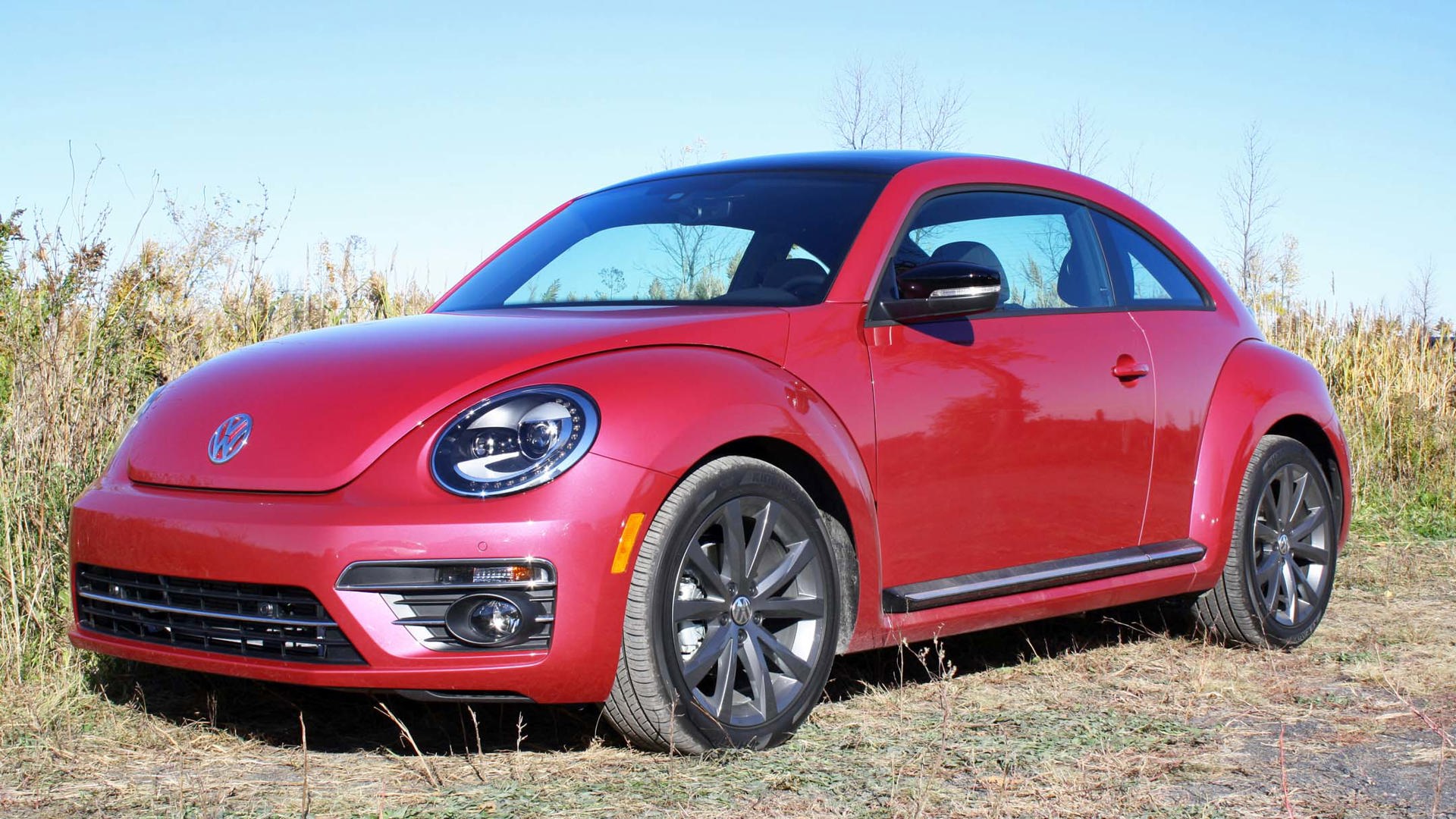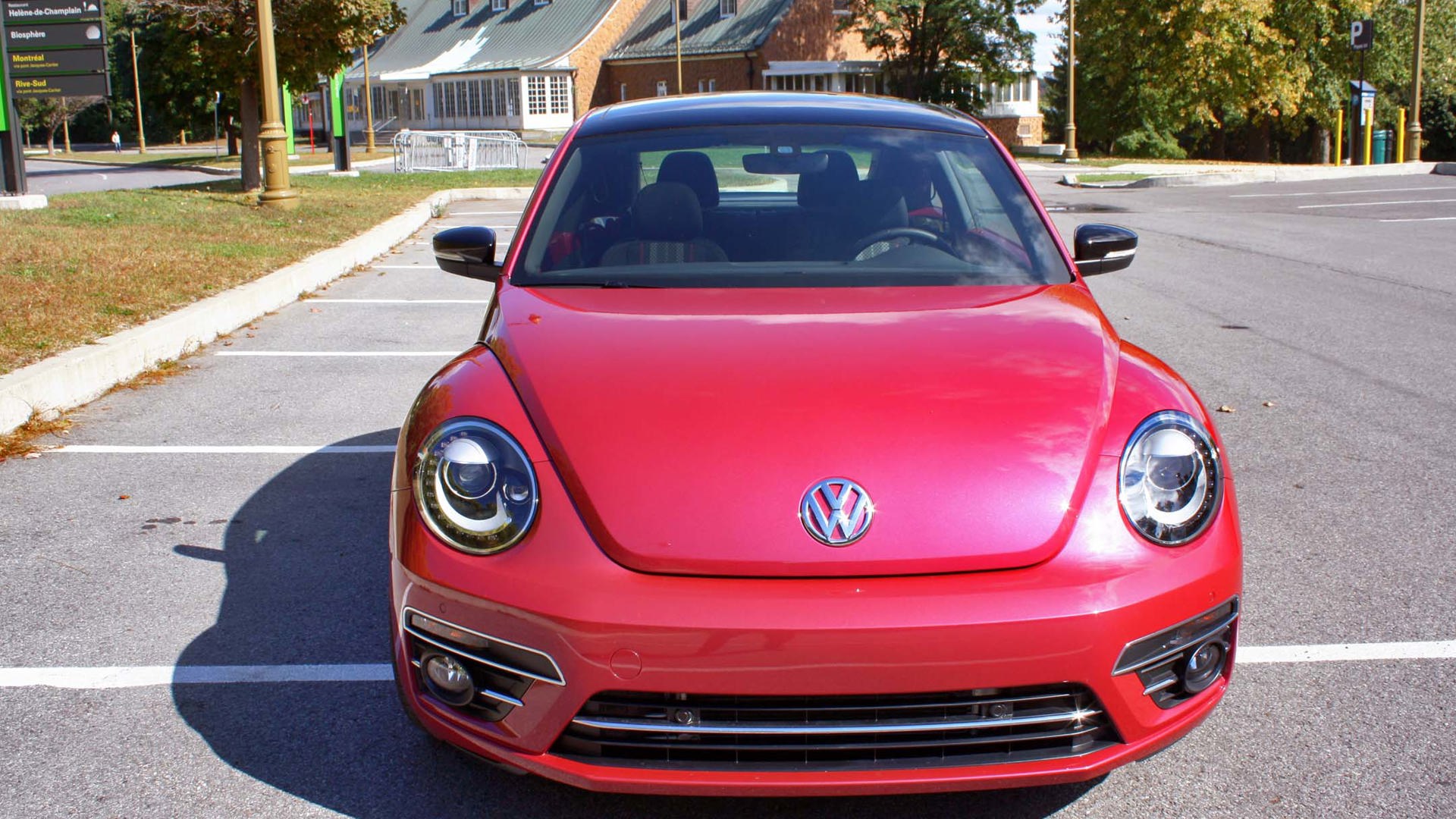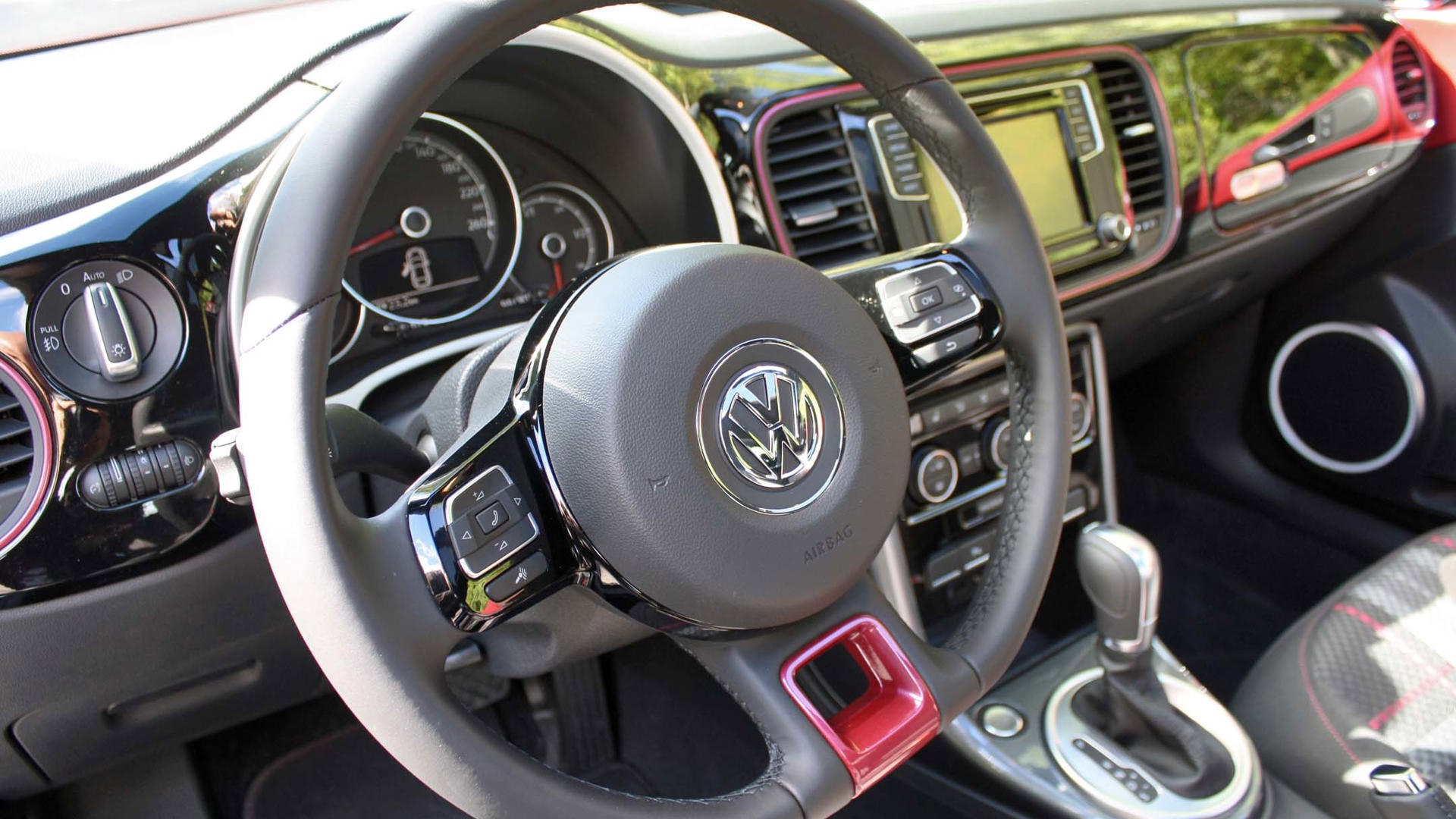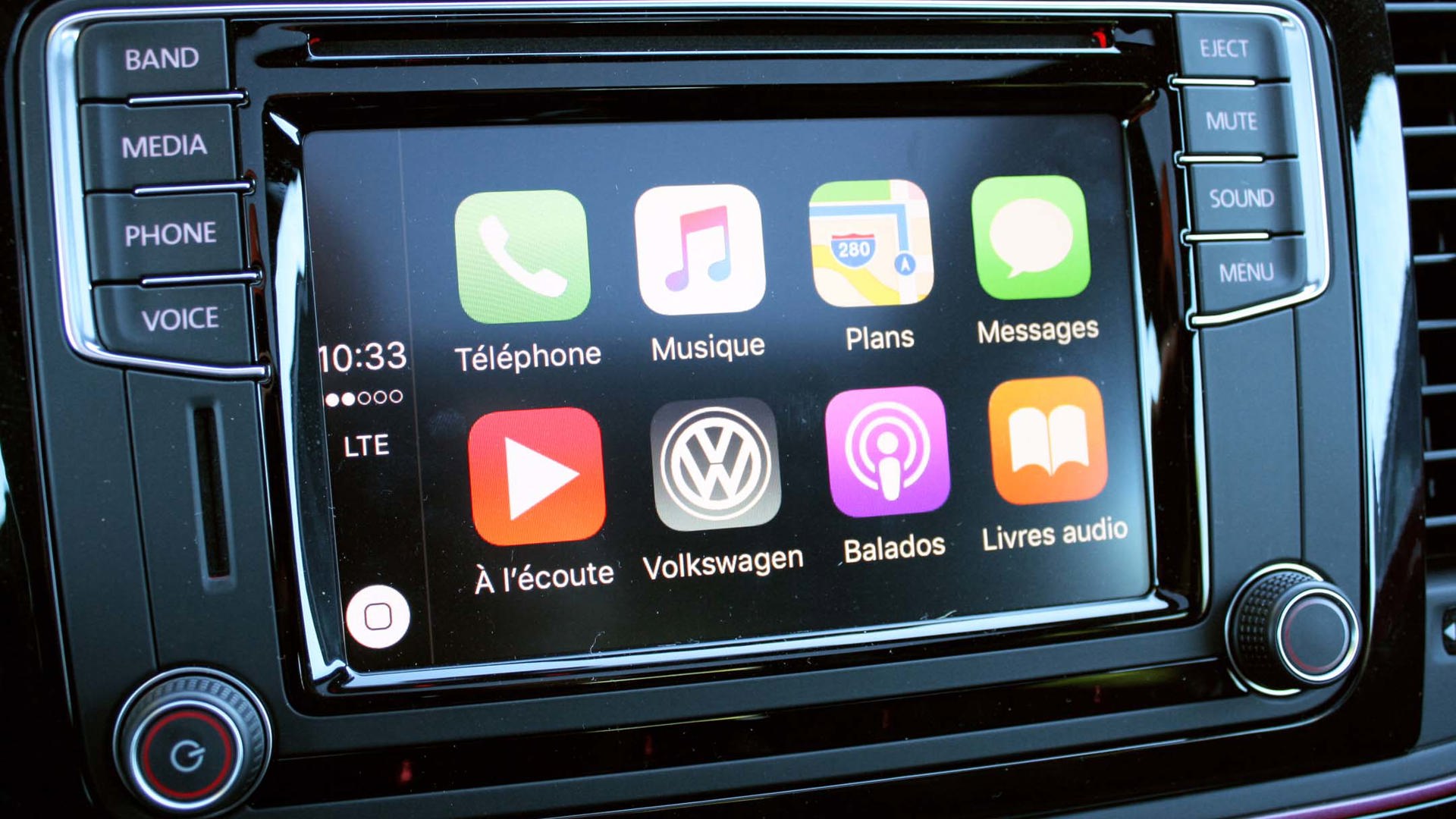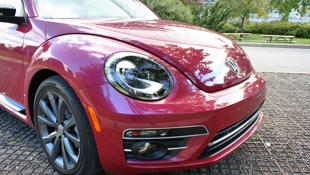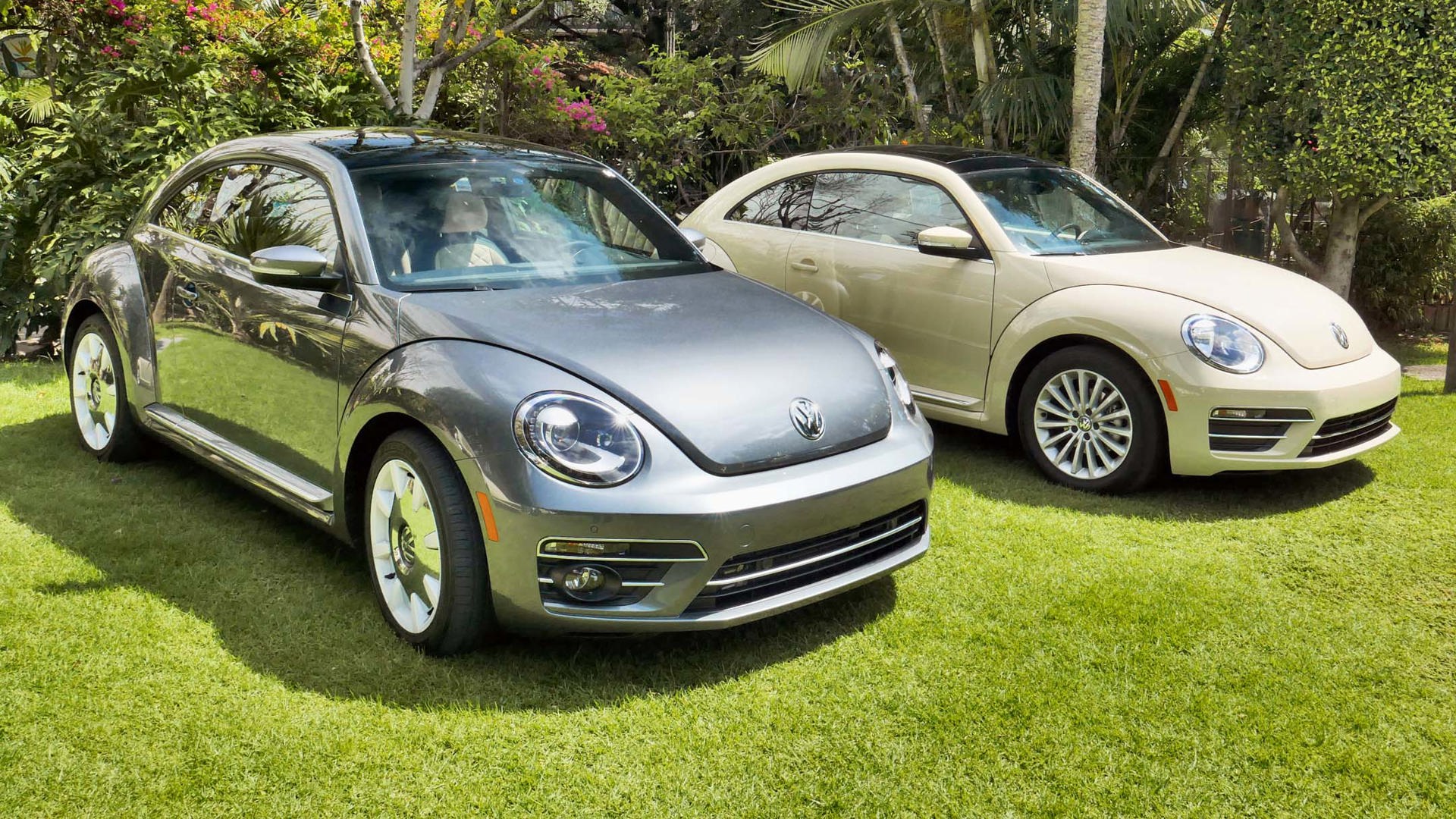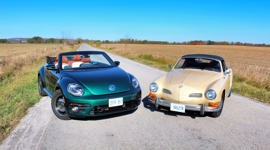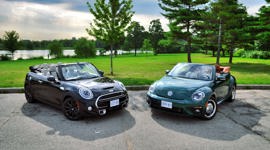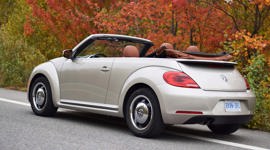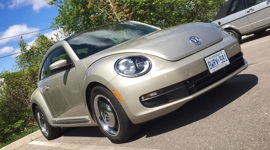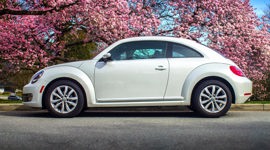 AutoTrader SCORE
AutoTrader SCORE
-
STYLING8/10
-
Safety8/10
-
PRACTICALITY6/10
-
USER-FRIENDLINESS7/10
-
FEATURES8/10
-
POWER7/10
-
COMFORT8/10
-
DRIVING FEEL8/10
-
FUEL ECONOMY6/10
-
VALUE9/10
We dare you not to smile
After spending a week with a German car designed for the one-percent, it’s only fitting that this time I take the wheel of another wagen made for the rest of us – it is the People’s Car, after all. The people who are a bit, ahem, extroverted, sure of themselves and ready for a bit of attention. Already in its sixth model year, the second coming of the water-cooled Beetle appears to be fuelled by 87 octane from the fountain of youth. Most outside observers see it as a brand-new model, a tribute to the car’s whimsical approach to the sea of generic grey, white and black crossovers that populate our roads. A Beetle stands out in the Costco parking lot like a Dr. Seuss tree in a nursery. Nobody will ever mistake that iconic shape for anything else.
(Yes, the hash sign is part of the name.)
To add to the distinctive shape, “Special Edition” and “Beetle” have been combined more times than I can remember (come to think of it, the only time I took the wheel of a New Beetle was in a “Vapor Yellow” special edition). For 2017, Volkswagen has realigned the Beetle range to set it further apart from its more conventional vehicles, focusing on a “special edition” approach to trim lines. The only concession to normality is the Trendline trim that remains at the entry level, starting at $19,990 and ready for Geek Squad duty. Up a notch, the chrome-hubcapped Classic becomes the bulk model, replacing last year’s Comfortline. Later in the year, the Denim edition of the Classic will return to showrooms, complete with denim-like upholstery and map pockets inspired by the back end of your Levi’s. The space-age Baja Bug tribute Dune is the range-topper, sprouting a new convertible version by spring. Sitting between the Classic and the Dune is this week’s colourful – make that very colourful – test subject, the 2017 Volkswagen Beetle #PinkBeetle. (Yes, the hash sign is part of the name.)
#PrettyInPink
Volkswagen regularly teases the crowds at auto shows with concept vehicles that may or may not reach production. Some wild jobs like the 2001 Microbus are just meant as styling exercises that may hint at future design directions, while others like the CrossBlue – the first draft of the Atlas production vehicle – are built to gauge the public’s reaction as the concept is refined towards reality. But the pre-Dieselgate VW was also known for its sense of humour, and always provided an un-German lighthearted atmosphere during automotive events, sprinkling the shape of its icon over its displays even before its 1998 rebirth. Indeed, the Beetle provides an ideal canvas for VW’s auto show booth designers, lending itself to fun creations with limitless crowd-pleasing possibilities. During the 2016 New York Auto Show, VW showed the “Pink Beetle Concept”, a very much production-feasible collage of features, fabric and trim themed around a modern, metallic pink paint hue. It was mentioned during the press conference that production of this concept would be considered depending on public reaction. And it seems the public was tickled pink with the idea.
First and foremost, before tweeting to all your followers that it is “Soooo cuuute, OMG I want a #PinkBeetle,” a word of warning: this special edition is also a very limited edition: only 100 coupes and 100 convertibles are allocated for Canada, and all have already left the paint booth – act fast. Second, in a sure sign that we’re living in times of social media domination, #PinkBeetle is the actual, official crowd-sourced name of this special trim. And third, it’s not actually pink – it’s Fresh Fuchsia Metallic. The polychromatic paint doesn’t scream “Barbie!” or “Mary Kay!” as much as anticipated once viewed in person. The playful shade harkens back to the Hot Wheels of our youths, pinkest in bright sunshine and nearly purple at night. Set off against aggressive-looking Adamantium (dark grey in VW-speak) 18-inch Ravenna wheels, a black panoramic sunroof surround and the R-Line body kit (glossy black mirror caps and running boards, and a rear hatch spoiler), the fuchsia paint comes out, at least to my eyes, more hot-rod than girlie-girl. Still, it’s an odd shade for a car that aims to be “more masculine” than the New Beetle. To help add testosterone to the buyers pool, all 2017 Beetles feature the more aggressive bumper caps from 2015’s R-Line trim.
Inside, the Beetle’s design lends itself well to coordination with exterior paint. As with all Beetles, the top of the door panels is covered in hard, shiny and slippery plastic, intended to mimic vintage Type-1 metal doors and painted to match the exterior. The same treatment extends to the rear windowsills. New for all 2017 Beetle trims is a painted center console frame, done in the same material; in the case of Miss Pink, it’s painted in a dark metallic grey. The flat face of the dashboard is rendered here in glossy black plastic, while pink rings adorn the dash vents and door pulls. Unique to the #PinkBeetle is the “Check Pink” upholstery, a cloth that covers all four seating positions. Even the floor mats get the treatment, with very subtle pink stitching. It all works, the only “loud” bit being the hot-pink trim piece at the bottom of the steering wheel.
The rest of the interior is standard Beetle fare. Except for armrests, the door interiors are hard plastic, and the retro elastic straps won’t secure much flotsam in the shallow door bins. The height-adjustable center armrest is comfortable, but doesn’t offer much storage. A open bin at the base of the console houses a single USB slot and one auxiliary jack – difficult to access but also too visible; when used to plug in a smartphone, one would wish for a lid to secure it from prying eyes or to hide messy wires. The main glovebox is set in the lower dash portion, while the vertical upper box is very shallow and mostly there for tradition. To compensate the lack of storage, the twin cupholders in the center console become de facto wallet and sunglasses receptacles.
Thanks to a tilting and telescoping steering wheel and multiple seating adjustments, a very good driving position is easy to achieve. Traditionalists will welcome VW’s use of its infamous rotating wheel seatback rake adjuster, although it’s quite a reach to access it. Ditto the seatbelts. With two long doors, the Beetle could benefit from a seatbelt guide on top of the seatback, but no such luck. To avoid physiotherapy sessions at my lovely wife’s clinic, I learned to reach for the belt at floor height with my left arm, and there’s plenty of clearance to do so. Accessing the rear is easier than it seems thanks to manual tilt / slide front seats (they’re a bit hard to push though). Once seated, you’ll have much more room back there than in a Fiat 500 or a standard Mini, the Beetle’s main competition, provided you’re not over six feet tall. Beetles only seat two in the back due to the car’s “heritage” styling, with a narrower body set between outboard wheels. Getting out of there is a cinch, thanks to vintage-style door straps to help you pull yourself up.
Out back, at 436 L the trunk is larger than one might expect, about two thirds of a Golf’s; I had no issues on a Costco run where I brought back three large boxes of Halloween chip bags. VW’s specs probably don’t deduct space for the optional Fender subwoofer, trading some room for boom. Unlike Minis, Beetles carry a full tool kit and a temporary spare under the trunk floor. Lowering the seatbacks won’t offer a flat loading floor, but nearly doubles the cargo capacity. The large hatch is pretty heavy. In a concession to style, it also lacks a rear wiper, and misty mornings showed the rear defogger can’t replace a proper rubber blade. As with the Golf, the rear VW emblem doubles as the trunk handle, and hides an always-clean rear-view camera. Cute, but not nearly as cute as the #PinkBeetle’s chromed “BUG” emblem!
#FullyLoaded
Bucking the trend of endless option catalogues favoured by most German manufacturers, all #PinkBeetles are sold as an all-inclusive trim line, with not a single available factory option, not even in the drivetrain department – the six-speed automatic with Tiptronic control is standard. Also standard is the Classic’s optional Style package, which includes a panoramic sunroof, two-zone climate control, Bi-Xenon headlights with LED daytime running lights, fog lights, LED taillights, keyless access, the Fender 400 watt digital audio upgrade, blind-spot detection and rear-traffic alert. Versus a Trendline, Miss Pink also features heated seats, heated washer nozzles, automated high beams, wipers and central rear-view mirror, trip computer, parking distance control, ambient lighting and leather-covered steering wheel rim, gearshift knob and handbrake and the “Composition Media” head unit (eight speakers, 6.33-inch touchscreen, CD player, SD card slot, Apple CarPlay and Android Auto compatibility). Unique to the #PinkBeetle is that chrome “Bug” badge on the rear decklid. It’s quite a bundle for $26,890, although thin cloth and hard plastics hint at where the money was saved. The only Beetle goodie you can’t get here is navigation, reserved for the Dune, but if you have a data plan with your smartphone, all you need is a USB cable to control your device’s map application through the infotainment system.
And speaking of that, this was my first contact with Apple CarPlay. The app requires you to activate Siri on your iPhone and plug in the device with a USB cable. Easier said than done, due to the location of the USB socket; in a dark parking garage, you will need a flashlight. Once set up, CarPlay is very convivial, and I was even able to dictate text messages after coming out of the dentist with half my mouth frozen by anaesthetics. Even in post-dentist French, Siri managed to understand me on the first try.
#TickledPink
The Beetle pre-dates the MQB platform, and as such it doesn’t benefit from the MkVII Golf’s premium-feel chassis. Most people still think of the Beetle as a Golf in iconic drag, but in fact the bubbly car is based on the platform of the current made-for-’Murica Jetta. At launch, the Beetle followed Jetta ethics by offering a twist-beam rear suspension on basic trims, while 2L turbo versions benefited from the GLI’s fancier multilink rear setup. As all Jettas upgraded to the fully independent rear suspension, so did the Beetle. Things also got standardized under the bulbous hood for 2017. TDI versions were yanked off the market before the end of 2015, of course, and for 2017 the high-zoot 210 hp turbo 2L shared with the GLI and GTI is no longer available. This leaves VW’s ubiquitous but excellent 1.8L TSI four-banger, still developing 170 hp on regular gas in this application, as the sole engine option for all 2017 Beetles. Bolted to this engine is a choice of five-speed manual or six-speed automatic transmissions, the latter being standard in the #PinkBeetle. Let’s not forget that this is a conventional, torque-converter automatic and not the dual-clutch DSG, even though it does offer a Tiptronic mode through a separate shifter gate, plus a sport mode. As with all VWs, disc brakes are found at all corners, and the big wheels are wrapped in 235/45R18 Hankooks.
I anticipated that my new fillings would be challenged once those big gumballs met our potholed pavement, but – surprise! – the ride is refined. The engineers made a great suspension / tire pairing, not always the case when you combine small car and big wheels. While no GTI, Miss Pink was still able to attack curvy on-ramps like few pink cars do, and even my commute’s infamous train track crossing did not upset the unsprung components (cough-cough, BMW). There’s a tad more road noise than in a Golf, most of it coming from the rear tires, perhaps amplified by the large hatch area. Wind noise is completely nil, proof that more upright windshields and large rear-view mirrors can tame airflow when properly designed. It’s also refreshing to be in a high-style vehicle that you can actually see out of – the view ahead is panoramic, with no distortion at all through the upright windshield. The big side windows simplify shoulder checks for lane changes, and out back the three-quarter view is almost unobstructed. The driver alert system adds visual blind-spot warnings in the rear-view mirrors, while a full sensor array helps keeping your fuchsia fresh in close parking quarters, even adding corresponding video alerts to the beeping. On the road, controls are where you expect them to be, except for the old-fashioned turn-signal-stalk-mounted cruise control. With good ergonomics, clear views and the highly legible new gauge package, it’s easy to pilot your ladybug in the urban jungle.
The TSI engine behaves like a larger four-banger, with a gruff and not really pleasing sound at lower speeds – maybe the GTI’s digital engine sounds could be of help here. The torque is there though, with no turbo tantrums – you won’t even hear it spin. It may sound indifferent, but the TSI has no issue keeping up with traffic, although it feels slower than the late, great TDI. Make no mistake, the TSI delivers above perception and Miss Pink scoots with assurance. The slushbox does it best to keep the revs down, and at city speeds sometimes you’d swear a CVT was down there, revs hovering barely above idle. Sixth gear keeps the revs really low on the highway, around 1,800 rpm at 100 km/h and 2,000 at 120. The tach is only graduated in thousands, so extrapolation is required here! Those low-rpm antics mean that stellar highway fuel economy is attainable, but around town things aren’t so … rosy.
#PiggyBank
Having established that this Beetle offers a great value proposition, how did it do at the pump? Well, after tackling Montreal traffic and running family errands for eight days and driving a tad more than 500 km, Miss Pink delivered 9.25 L/100km at the pump, against 9.6 indicated by the pessimistic trip computer. 2017 data is not available yet, but for 2016 the Beetle’s Energuide ratings were 9.6 L/100km city, 7.0 highway and 8.4 combined, for the TSI engine paired to the six-speed automatic. While not terrific for a compact, my real-world numbers fall right into the lab ratings given the number of short trips and morning line-ups at the Victoria Bridge. At least, like all 1.8 TSI engines, Miss Pink uses regular unleaded, not premium. My initial highway-only drive after picking up the car finished with an indicated 7.2 L/100km, so I’m confident the Beetle can at least match its highway ratings.
The Beetle remains a practical but whimsical alternative in a compact car world where all alternatives seem to be slowly morphing into similar blobs. A lot of neo-retro vehicles have come and gone since the PT Cruiser was launched, and few remain today. Last year, rumours swirled that there would be no follow-up to the current Beetle, a disheartening state of affairs. Beetles, especially pink ones, aren’t for everyone. But as we ride towards that autonomous pod apocalypse, we should embrace everyday extrovert cars that celebrate the freedom of choice, individuality, expressiveness and, quite simply, good ’ole fun. So release your inner Ken. Barbie will be asking you for rides. #Smile
| Engine Displacement | 1.8L |
|---|---|
| Engine Cylinders | 4 |
| Peak Horsepower | 170 hp @ 6,200 rpm |
| Peak Torque | 184 lb-ft @ 1,500–4,750 rpm |
| Fuel Economy | 9.6 / 7.0 / 8.4 (L/100 km, city/hwy/comb) (2016 data) |
| Cargo Space | 440 L, 850 L w/ rear seats folded |
| Model Tested | 2017 Volkswagen Beetle Coupe #PinkBeetle |
| Base Price | $26,890 |
| A/C Tax | $100 |
| Destination Fee | $1,625 |
| Price as Tested | $28,615 |
|
Optional Equipment
None
|
|
